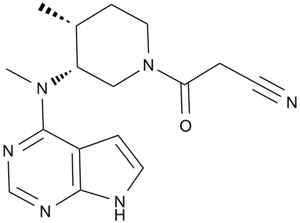Tofacitinib (CP690550; tasocitinib)
This product is for research use only, not for human use. We do not sell to patients.

For small sizes, please check our retail website as below: www.invivochem.com
| Size | Price | Stock |
|---|---|---|
| 500mg | $300 | In Stock |
| 1g | $500 | In Stock |
| 5g | $1265 | In Stock |
Cat #: V0342 CAS #: 477600-75-2 (free base) Purity ≥ 98%
Description: Tofacitinib (also known as tasocitinib or CP-690550, sold under the brand Xeljanz), is a novel and potent inhibitor of JAK3 (Janus-Associated kinase) with potential anti-inflammatory activity.
Top Publications Citing Invivochem Products
Publications Citing InvivoChem Products
Product Promise

- Physicochemical and Storage Information
- Protocol
- Related Biological Data
- Stock Solution Preparation
- Quality Control Documentation
| Molecular Weight (MW) | 312.37 |
|---|---|
| Molecular Formula | C16H20N6O |
| CAS No. | 477600-75-2 (free base) |
| Storage | -20℃ for 3 years in powder formr |
| -80℃ for 2 years in solvent | |
| Solubility In Vitro | DMSO: 62 mg/mL (198.5 mM)r |
| Water: <1 mg/mLr | |
| Ethanol: <1 mg/mL | |
| Solubility In Vivo | 30% PEG400+0.5% Tween80+5% propylene glycol: 30 mg/mL |
| SMILES Code | N#CCC(N1C[C@H](N(C)C2=C3C(NC=C3)=NC=N2)[C@H](C)CC1)=O |
| Synonyms | CP-690550; CP690550; CP 690550; Tasocitinib; Tofacitinib; Xeljanz (Trade name); Tofacitinib free base; |
| Protocol | In Vitro | Tofacitinib (CP-690550) citrate binds potentially at JAK3 and JAK2 as 2.2 nM and 5 nM (Kd). The report includes additional binding for Tofacitinib at Camk1 (Kd of 5,000 nM), DCamkL3 (Kd of 4.5 nM), Mst2 (Kd of 4,300 nM), Pkn1 (Kd of 200 nM), Rps6ka2 (Kin.Dom.2-C-terminal) (Kd of 1,400 nM), Rps6ka6 (Kin.Dom.2-C-terminal) (Kd of 1,200 nM), Snark (Kd of 420 nM), Tnk1 (Kd of 640 nM) and Tyk2 (Kd of 620 nM). |
|---|---|---|
| In Vivo | Animals that are treated with Tofacitinib show a significantly lower production of anti-drug antibodies (ADAs) compare with PEG-treated control mice (for five weeks after initial immunization, p<0.01, n=8). Moreover ADAs become detectable earliest on day 28. A difference of 1000- to 200-fold in titers to SS1P is apparent from days 21 through 35, respectively. Compare to SS1P, mice injected with keyhole limpet hemocyanin (KLH) generate a more rapid antibody response. Yet, the administration of Tofacitinib reduces anti-KLH titers compare to controls (p<0.05 on day 21, p<0.01 on day 28, respectively, n=5). Reductions in titers ranged from 5000- to 250-fold from days 21 through 28, respectively. |
These protocols are for reference only. InvivoChem does not
independently validate these methods.
| Solvent volume to be added | Mass (the weight of a compound) | |||
|---|---|---|---|---|
| Mother liquor concentration | 1mg | 5mg | 10mg | 20mg |
| 1mM | 3.2013 mL | 16.0067 mL | 32.0133 mL | 64.0266 mL |
| 5mM | 0.6403 mL | 3.2013 mL | 6.4027 mL | 12.8053 mL |
| 10mM | 0.3201 mL | 1.6007 mL | 3.2013 mL | 6.4027 mL |
| 20mM | 0.1601 mL | 0.8003 mL | 1.6007 mL | 3.2013 mL |
The molarity calculator equation
Mass(g) = Concentration(mol/L) × Volume(L) × Molecular Weight(g/mol)
Mass
=
Concentration
×
Volume
×
Molecular Weight*
The dilution calculator equation
Concentration(start)
×
Volume(start)
=
Concentration(final)
×
Volume(final)
This equation is commonly abbreviated as: C1 V1 = C2 V2
Concentration(start)
C1
×
Volume(start)
V1
=
Concentration(final)
C2
×
Volume(final)
V2
Step One: Enter information below
Dosage mg/kg
Average weight of animals g
Dosing volume per animal µL
Number of animals
Step Two: Enter the in vivo formulation
%DMSO
+
%
+
%Tween 80
+
%ddH2O
Calculation Results:
Working concentration:
mg/ml;
Method for preparing DMSO master liquid:
mg
drug pre-dissolved in
µL
DMSO(Master liquid concentration
mg/mL)
,Please contact us first if the concentration exceeds the DMSO solubility of the batch of drug.
Method for preparing in vivo formulation:
Take
µL
DMSO master liquid, next add
µL
PEG300, mix and clarify, next add
µL
Tween 80,mix and clarify, next add
µL
ddH2O,mix and clarify.
Note:
- (1) Please be sure that the solution is clear before the addition of next solvent. Dissolution methods like vortex, ultrasound or warming and heat may be used to aid dissolving.
- (2) Be sure to add the solvent(s) in order.




































